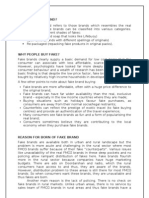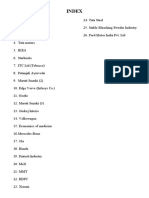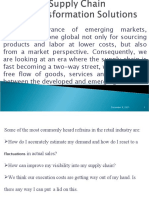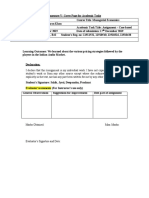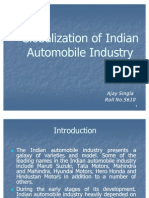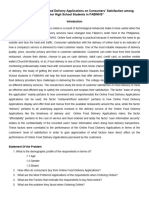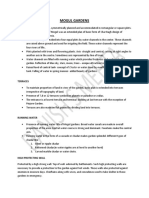100%(1)100% found this document useful (1 vote)
96 viewsSwot Analysis For Consumer Non
Swot Analysis For Consumer Non
Uploaded by
flash vszoomThis document provides a SWOT analysis and Porter's Five Forces analysis for the consumer non-durables (FMCG) sector in India. It identifies strengths such as established distribution networks and well-known brands, as well as weaknesses like low investment in research. Opportunities include India's large population and rising incomes, while threats include tax structure changes and slowdowns in rural demand. Porter's Five Forces analysis examines factors like the bargaining power of suppliers and buyers and competitive rivalry in the industry.
Copyright:
© All Rights Reserved
Available Formats
Download as DOCX, PDF, TXT or read online from Scribd
Swot Analysis For Consumer Non
Swot Analysis For Consumer Non
Uploaded by
flash vszoom100%(1)100% found this document useful (1 vote)
96 views3 pagesThis document provides a SWOT analysis and Porter's Five Forces analysis for the consumer non-durables (FMCG) sector in India. It identifies strengths such as established distribution networks and well-known brands, as well as weaknesses like low investment in research. Opportunities include India's large population and rising incomes, while threats include tax structure changes and slowdowns in rural demand. Porter's Five Forces analysis examines factors like the bargaining power of suppliers and buyers and competitive rivalry in the industry.
Original Title
Swot Analysis for Consumer Non
Copyright
© © All Rights Reserved
Available Formats
DOCX, PDF, TXT or read online from Scribd
Share this document
Did you find this document useful?
Is this content inappropriate?
This document provides a SWOT analysis and Porter's Five Forces analysis for the consumer non-durables (FMCG) sector in India. It identifies strengths such as established distribution networks and well-known brands, as well as weaknesses like low investment in research. Opportunities include India's large population and rising incomes, while threats include tax structure changes and slowdowns in rural demand. Porter's Five Forces analysis examines factors like the bargaining power of suppliers and buyers and competitive rivalry in the industry.
Copyright:
© All Rights Reserved
Available Formats
Download as DOCX, PDF, TXT or read online from Scribd
Download as docx, pdf, or txt
100%(1)100% found this document useful (1 vote)
96 views3 pagesSwot Analysis For Consumer Non
Swot Analysis For Consumer Non
Uploaded by
flash vszoomThis document provides a SWOT analysis and Porter's Five Forces analysis for the consumer non-durables (FMCG) sector in India. It identifies strengths such as established distribution networks and well-known brands, as well as weaknesses like low investment in research. Opportunities include India's large population and rising incomes, while threats include tax structure changes and slowdowns in rural demand. Porter's Five Forces analysis examines factors like the bargaining power of suppliers and buyers and competitive rivalry in the industry.
Copyright:
© All Rights Reserved
Available Formats
Download as DOCX, PDF, TXT or read online from Scribd
Download as docx, pdf, or txt
You are on page 1of 3
Swot analysis for consumer non-durables sector (FMCG)
By: Jeh Shah
Consumer nondurable goods are purchased for immediate or almost immediate consumption
and have a life span ranging from minutes to three years. Common examples of these are
food, beverages, clothing and shoes
The top 10 FMCG companies in India are:
1. HUL (Hindustan Unilever LTD)
2. ITC Ltd
3. Nestle India Ltd
4. Britannia Industries Ltd
5. Godrej Consumer Products Ltd
6. Patanjali Ayurveda Limited
7. Dabur India Ltd
8. Marico Ltd
9. Varun Beverages Ltd
10. GlaxoSmithKline Consumer Healthcare Ltd
Strength Weakness
Low operational costs Low scope of investing in Research and
Presence of established distribution networks in technology and achieving economies of scale.
both urban and rural areas Low levels of exports.
Presence of well-known brands in FMCG sector Many counterfeit products in the markets
Deep roots in local sector and great specially in rural and semi urban markets.
understanding of consumer needs
SWOT ANALYSIS
Opportunities
Threats
Large domestic market with over 1.3 billion
people. removal of import restrictions resulting in
Good export potential.
replacement of domestic brands
Untapped large rural market. slowdown in rural demand
Rising income levels and increase in purchasing tax structure
power.
high consumer goods spending
Porters Five Force Model
Bargaining Power of Suppliers (Low)
Big FMCG companies are able to dictate the prices through local sourcing from a fragmented group
of key commodity suppliers
Bargaining Power of Buyers (High)
Low switching cost induces the customers’ product shift
Influence of marketing strategies
Availability of same or similar alternatives
Threats of substitutes (High)
Presence of multiple brands
Narrow product differentiation under many brands
Price war
Threats of New enterants (Medium)
Huge investments in setting up distribution network and promoting brands
Spending on advertisements is aggressive
Competitive rivalry (High)
Private label brands by retailers are priced at a discount to mainframe brands limits competition for
the weak brands
Highly fragmented industry as more MNCs are entering
You might also like
- Time Value of Money ConceptsDocument341 pagesTime Value of Money ConceptsArn Kyla100% (1)
- Using Social Media To Track Trends For Real-Time InsightsDocument2 pagesUsing Social Media To Track Trends For Real-Time InsightsMd Tareq100% (1)
- Case StudyDocument15 pagesCase StudyDHWANI JAINNo ratings yet
- PWC Winning in India Retail SectorDocument60 pagesPWC Winning in India Retail SectorsandipgargNo ratings yet
- Rural Marketing Course Outline PDFDocument4 pagesRural Marketing Course Outline PDFSaksham GoyalNo ratings yet
- HUL Rural MarketingDocument22 pagesHUL Rural Marketingtoto04858100% (1)
- Unilever Platinum Stores - Building A Brand For The Community (Part1)Document6 pagesUnilever Platinum Stores - Building A Brand For The Community (Part1)jayNo ratings yet
- Smartphones - A Microeconomic AnalysisDocument27 pagesSmartphones - A Microeconomic AnalysisIshan ShahNo ratings yet
- Agri Assignment FinalDocument10 pagesAgri Assignment Finalkanika1992No ratings yet
- NullDocument4 pagesNullZunairaNo ratings yet
- MOSP Final Project - ITC - Group7 - SectionCDocument29 pagesMOSP Final Project - ITC - Group7 - SectionCArjun JainNo ratings yet
- SWOT Analysis of Indian EconomyDocument11 pagesSWOT Analysis of Indian EconomyArathi BmNo ratings yet
- Reliance Fresh Macro-Environmental AnalysisDocument3 pagesReliance Fresh Macro-Environmental Analysisssagr123No ratings yet
- Marketing Plan HorlicksDocument17 pagesMarketing Plan HorlicksMd. Azad Hossain0% (1)
- BM Session Brand ExtensionsDocument14 pagesBM Session Brand ExtensionsPadmanabhan NsNo ratings yet
- Recession in IndiaDocument16 pagesRecession in Indiasonuka98% (63)
- Internal Analysis of InfosysDocument3 pagesInternal Analysis of InfosysWilliam McconnellNo ratings yet
- SWOT Analysis of IT and ITES Sector: StrengthsDocument3 pagesSWOT Analysis of IT and ITES Sector: StrengthsRahul MahajanNo ratings yet
- Porter's Five Force Analysis of Industry: Rivalry Among Competitors - Attractiveness: HighDocument5 pagesPorter's Five Force Analysis of Industry: Rivalry Among Competitors - Attractiveness: HighPrasanta MondalNo ratings yet
- Final Glaxosmithkline (GSK) - Case Study OnDocument17 pagesFinal Glaxosmithkline (GSK) - Case Study OnAvinash KumarNo ratings yet
- ChanelDocument25 pagesChanelAleksandraVukašinovićNo ratings yet
- Dabur India Ltd.Document52 pagesDabur India Ltd.Sagacious NItin100% (1)
- Consumer Research Powerpoint - Advertising To Millinnials and Generation ZDocument20 pagesConsumer Research Powerpoint - Advertising To Millinnials and Generation Zapi-541859938No ratings yet
- What Is FMCGDocument17 pagesWhat Is FMCGRashi SinghNo ratings yet
- IT Project For Asian PaintsDocument6 pagesIT Project For Asian PaintsPranav SiddharthNo ratings yet
- PESTEL Analysis of Organized Jewellery SectorDocument5 pagesPESTEL Analysis of Organized Jewellery SectorSIMRAN SHOKEENNo ratings yet
- Structural Analysis of Telecommunication and Tele Services IndustryDocument6 pagesStructural Analysis of Telecommunication and Tele Services IndustryVigneshwarNo ratings yet
- Assignment Topic: Risk Factors Involved in FMCG Sector / in Any Manufacturing UnitDocument13 pagesAssignment Topic: Risk Factors Involved in FMCG Sector / in Any Manufacturing UnitGaurav DeshwalNo ratings yet
- Power Point Presentation On Pricing Strategy and Brand ManagementDocument34 pagesPower Point Presentation On Pricing Strategy and Brand Managementlegese lemmaNo ratings yet
- Category Attractiveness Analysis of WatchesDocument8 pagesCategory Attractiveness Analysis of WatchesCharmimgParthaNo ratings yet
- AAA NotesDocument9 pagesAAA NotessunnybakliwalNo ratings yet
- Infosys StrategyDocument11 pagesInfosys StrategyRashmi SinghNo ratings yet
- US China Trade War Impact On IndiaDocument6 pagesUS China Trade War Impact On IndiaAryan MaheshwariNo ratings yet
- Pps CH 7, PLC Pricing.Document24 pagesPps CH 7, PLC Pricing.amnahbatool785No ratings yet
- Fake Brand AssignmentDocument5 pagesFake Brand AssignmentMeetu RawatNo ratings yet
- P&G SwotDocument8 pagesP&G SwotAnant MittalNo ratings yet
- St. MGMT Bata A # 2Document26 pagesSt. MGMT Bata A # 2Muhammad Afzal100% (1)
- Instructions:: (1) All Questions Are Compulsory. Q1 - 10 Marks Q2-10 MarksDocument1 pageInstructions:: (1) All Questions Are Compulsory. Q1 - 10 Marks Q2-10 MarksYogesh WaghNo ratings yet
- Micro AnalysisDocument289 pagesMicro AnalysisAPOORV ASTHANANo ratings yet
- Shanghai Tang-Q1Document11 pagesShanghai Tang-Q1Sakshi ShahNo ratings yet
- Capstone OrginalDocument33 pagesCapstone Orginalshubham palNo ratings yet
- CAGE (France)Document4 pagesCAGE (France)Farhad KabirNo ratings yet
- Challenges Faced by Kirana StoresDocument9 pagesChallenges Faced by Kirana StoresAnand Vinod Kumar100% (1)
- Infosys Supply ChainDocument11 pagesInfosys Supply ChainAmit BharNo ratings yet
- Cottle TaylorDocument5 pagesCottle TaylorRahul MallikNo ratings yet
- Indian Audio Market Q1939Document6 pagesIndian Audio Market Q1939sebbyNo ratings yet
- A Report On FMCG Industry in IndiaDocument7 pagesA Report On FMCG Industry in IndiabalajinsbNo ratings yet
- Leo Burnett IndiaDocument17 pagesLeo Burnett IndiaAdnan patelNo ratings yet
- ChotuKool Case AnalysisDocument4 pagesChotuKool Case AnalysisaishabadarNo ratings yet
- Big Bazaar Strategic AnalysisDocument16 pagesBig Bazaar Strategic Analysisprakashprabum0% (1)
- Globalization of Indian Automobile IndustryDocument25 pagesGlobalization of Indian Automobile IndustryAjay Singla100% (2)
- Horlicks Asha - An Initiative To Target Bottom of The Pyramid MarketDocument6 pagesHorlicks Asha - An Initiative To Target Bottom of The Pyramid Marketmukeshpra007gmailcomNo ratings yet
- Assignment On Case StudyDocument4 pagesAssignment On Case Studyτυσηαρ ηαβιβ0% (2)
- Parallel Channel EnvironmentDocument2 pagesParallel Channel EnvironmentSaumya SharmaNo ratings yet
- Managing Britannia: Culture and Management in Modern BritainFrom EverandManaging Britannia: Culture and Management in Modern BritainRating: 4 out of 5 stars4/5 (1)
- Swot Analysis For Consumer NonDocument3 pagesSwot Analysis For Consumer Nonflash vszoomNo ratings yet
- Fast Moving Consumer GoodsDocument16 pagesFast Moving Consumer GoodsTushar Mane100% (2)
- Introduction of AcquirerDocument25 pagesIntroduction of AcquirerMohit MidhaNo ratings yet
- Rural MKTG of FMCGsDocument9 pagesRural MKTG of FMCGsRichBrook7No ratings yet
- The Changing Indian Consumer Durables Industry-An Outlook: Project Report ONDocument31 pagesThe Changing Indian Consumer Durables Industry-An Outlook: Project Report ONSathiya RajNo ratings yet
- Swot Analysis For Consumer NonDocument3 pagesSwot Analysis For Consumer Nonflash vszoomNo ratings yet
- Company Ambuja CementsDocument5 pagesCompany Ambuja Cementsflash vszoomNo ratings yet
- Company ACC LTDDocument6 pagesCompany ACC LTDflash vszoomNo ratings yet
- Company HUL LTDDocument6 pagesCompany HUL LTDflash vszoomNo ratings yet
- Emami LTD.: General OverviewDocument5 pagesEmami LTD.: General Overviewflash vszoomNo ratings yet
- Theory of Planning Behavior (TPB) andDocument19 pagesTheory of Planning Behavior (TPB) andnurfatehah265No ratings yet
- 3001 Oral Rubric Revised TamaraDocument2 pages3001 Oral Rubric Revised TamaraTamaraJ.G.BarbosaNo ratings yet
- The Impact of Online Food Delivery Applications On ConsumersDocument1 pageThe Impact of Online Food Delivery Applications On ConsumersRona Mae MirandaNo ratings yet
- Advancements in Transmission Line Fault LocationDocument143 pagesAdvancements in Transmission Line Fault LocationtunghtdNo ratings yet
- P&FDocument10 pagesP&FPriyanka GaikwadNo ratings yet
- 02-Random VariablesDocument38 pages02-Random Variablesmilkiyas mosisaNo ratings yet
- Example of Bit StuffingDocument5 pagesExample of Bit StuffingpradeeperukullaNo ratings yet
- Santa Barbara County Calle Real Campus Master Plan PresentationDocument11 pagesSanta Barbara County Calle Real Campus Master Plan Presentationgiana_magnoliNo ratings yet
- Medical Marijuana: Is The Cart Before The Horse?Document2 pagesMedical Marijuana: Is The Cart Before The Horse?Southern California Public RadioNo ratings yet
- UP Graduate Studies Reference ReportDocument1 pageUP Graduate Studies Reference ReportmikollimNo ratings yet
- AP Statistics - Chapter 8 Notes: Estimating With Confidence 8.1 - Confidence Interval BasicsDocument2 pagesAP Statistics - Chapter 8 Notes: Estimating With Confidence 8.1 - Confidence Interval BasicsRhivia LoratNo ratings yet
- Robust Estimation Methods and Outlier Detection in Mediation ModelDocument25 pagesRobust Estimation Methods and Outlier Detection in Mediation ModelJoanne WongNo ratings yet
- MYP Framework Grade 10Document3 pagesMYP Framework Grade 10Mandane Azul Kim PearlNo ratings yet
- Anshul Mishra: B 131, St. 14, Smiriti Nagar, Bhilai, Chhattisgarh, 9630042438Document4 pagesAnshul Mishra: B 131, St. 14, Smiriti Nagar, Bhilai, Chhattisgarh, 9630042438patelshishirNo ratings yet
- Leader in Innovative Packaging Solutions: Process Operating ManualDocument11 pagesLeader in Innovative Packaging Solutions: Process Operating ManualLyonelNo ratings yet
- Design Criteria For Structural Design of Silage Silo Walls: July 2012Document7 pagesDesign Criteria For Structural Design of Silage Silo Walls: July 2012Bayari ArNo ratings yet
- Tooth Discoloration: DR Bindu Kumari (BDS)Document32 pagesTooth Discoloration: DR Bindu Kumari (BDS)محمد العراقيNo ratings yet
- Mogul GardensDocument2 pagesMogul GardensDanish S MehtaNo ratings yet
- Homeroom Guidance Week 3-4Document3 pagesHomeroom Guidance Week 3-4cutiepie creampie100% (4)
- IR - Jawaban Pertanyaan OlerDocument2 pagesIR - Jawaban Pertanyaan OlerIndra RamadhanyNo ratings yet
- Applied Economics Module 1Document30 pagesApplied Economics Module 1愛結No ratings yet
- Statement of Purpose (Ashok)Document2 pagesStatement of Purpose (Ashok)Sagar AryalNo ratings yet
- Lapaoran Teleng & EPMSDocument22 pagesLapaoran Teleng & EPMSRii UtamiNo ratings yet
- E426 E3nx-Fa Brochure enDocument12 pagesE426 E3nx-Fa Brochure enridhaNo ratings yet
- Grade Control Drilling With RC and QAQC of SampleDocument43 pagesGrade Control Drilling With RC and QAQC of SampleJulian I Swandi100% (4)
- Biogas FlaresDocument12 pagesBiogas Flaresdit25195683100% (1)
- Job Description - Data OfficerDocument4 pagesJob Description - Data OfficerTracy Halfpenny LondonNo ratings yet
- Case Comment On Indian Young Lawyers Association V. The State of KeralaDocument19 pagesCase Comment On Indian Young Lawyers Association V. The State of KeralaKrishna Ahuja100% (1)
- Fire Detection Panel: Programming ManualDocument77 pagesFire Detection Panel: Programming ManualAddaNo ratings yet


































